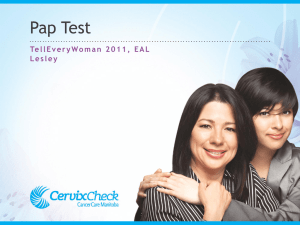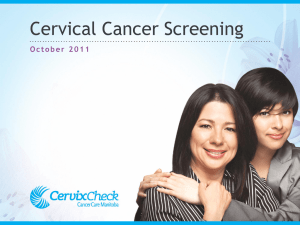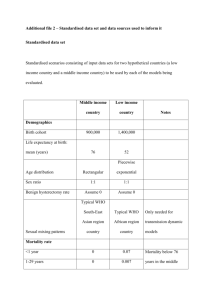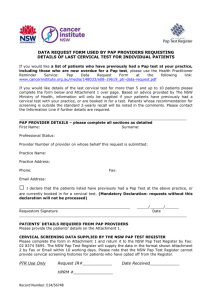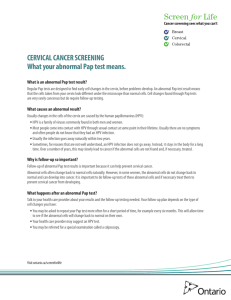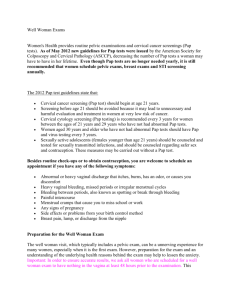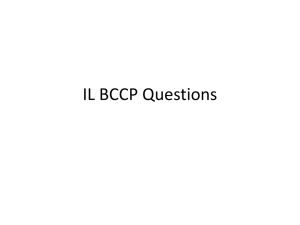Title of QI Project
advertisement
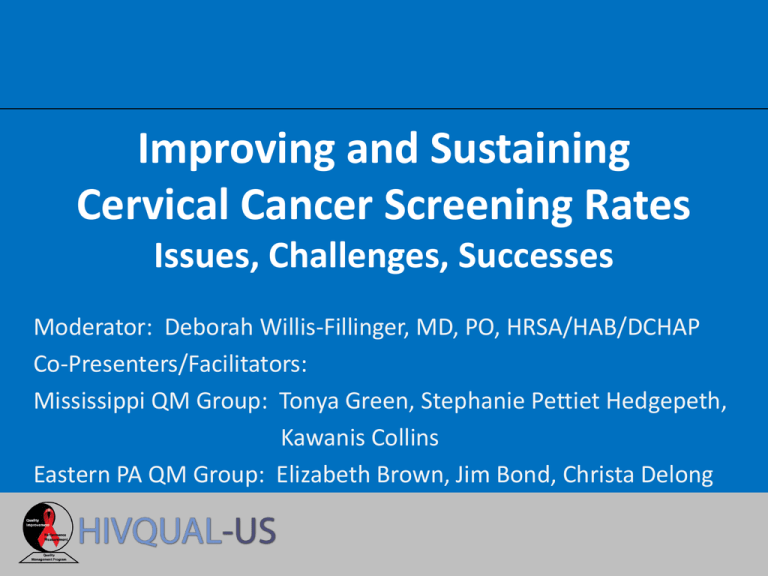
Improving and Sustaining Cervical Cancer Screening Rates Issues, Challenges, Successes Moderator: Deborah Willis-Fillinger, MD, PO, HRSA/HAB/DCHAP Co-Presenters/Facilitators: Mississippi QM Group: Tonya Green, Stephanie Pettiet Hedgepeth, Kawanis Collins Eastern PA QM Group: Elizabeth Brown, Jim Bond, Christa Delong Workshop Assumptions We all have an interest in women’s health. We all have experience; however we don’t have the answers. We’re here to learn about improving HIV+ women’s health with a focus on annual Pap screens Let’s reach a better understanding together. Workshop Learning Outcomes By the end of this workshop, participants will be able to: • Engage in a dialogue with grantees about their experiences with • Improving cervical cancer screening rates, • Facing challenges from multiple perspectives – organizational, supportive services, and patient level, and • Sustaining improvements. • Identify successful approaches and interventions. Agenda 3:00 Welcome. Renewing Commitment 3:15 Tough Road To Sustained Improvement Benchmarking data and results Reasons for variable rates 3:30 Improvement Experiences in MS and E. PA 3:55 Small Group Exchange 4:15 Large group sharing and summation. 4:30 Adjourn. Thank you! Renewing Commitment Cervical Cancer Screening The Clinical Case Deborah Willis-Fillinger, MD HRSA/HAB/DCHAP AGM 2012 Shorter Survival For Women? • Analysis of studies involving more than 4,500 people with HIV infection revealed women were 33 percent more likely than men to die within the study period. 1990- 1995 • New York City AIDS Surveillance data from 1990 to 1995, observed cervical cancer cases in HIV-positive women were two to three times higher than the expected number of cases.6,7 2007- 2009 • By 2009, in the U.S., women accounted for more than 25% of the new HIV infections. • For women the most common methods of transmission were high-risk heterosexual contact and injection drug use. What We Can Do…. • Cervical cancer can be prevented or detected in its earliest stages through effective Pap smear screening. • Even HIV-infected women with invasive cervical cancer tend to do well with surgery and treatment and good immune function • Accentuates the importance of routine Pap smears for HIV-infected women.13 Human Papillomavirus (HPV) • Common infection in the general population. • Over 50% of sexually active adults have been infected with one or more HPV types. • Within 5 years of sexual debut—70% have HPV HPV 16-18 and Pap Co-Tests? • 100 genotypes of HPV – 15 cause cancer • HPV 16 & 18 = 70% of cervical cancer • Co-Testing for HPV with Pap Smears may Increase predictive value of cervical cancer screenings.. More to come.. • Current Guidelines…. Tough Road To Sustaining Improvement Experience National Benchmarking Data – 2007-09 HIVQUAL GYN Care Indicator GYN Care in review period 3,640 women eligible in 2009 Eligible/denominator: at least one clinical Visit in each 6-month period of the review period. Clinic mean for patients who had both a pelvic exam and a Pap test: 69% to 62% GYN Care 96%93% 100% 80% 69% 90% 85% 62% 60% 40% Of 2,293 women with a pelvic and pap smear, clinic mean of –23% (556) abnormal –With clinic mean of 90% (487) referred for follow-up 20% 0% Pap and Pelvic (all females) Pap test (among those with a Pelvic exam) 2007 C/D Follow-up for abnormal Pap 2009 C/D 13 What is Your Measure? What are Your Rates? How many of you are using HRSA/HAB performance measure for Cervical Cancer Screening? Percentage of women with HIV infection who have a Pap screening in the measurement year • Numerator: Number of HIV-infected female clients who had Pap screen results documented in the measurement year • Denominator: Number of HIV-infected female clients who: – were >18 years old1 in the measurement year or reported having a history of sexual activity , and – had a medical visit with a provider with prescribing privileges2 at least once in the measurement year What are your results? Please raise your hands. How many have results? How many have sustained their results after improvement efforts? < 50% 50% - 60% 60% - 70% 70% - 80% 80% - 90% 90% - 100% Are we still facing the same reasons for low rates or variable rates? Program Data from 2008 Mississippi Statewide Quality Management HIVQUAL Group Part C Grantee Representatives Successful Interventions Can they be sustained? • Southeast Mississippi Rural Health, Inc. (SeMRHI) – Tonya Green • Crossroads Clinics North – Stephanie Pettiet Hedgepeth • Magnolia Medical Clinic – Kawanis Collins Who do we serve in Mississippi? • Percentage of HIV+ female patients • Percentage of African American, White, Hispanic, Other • Percentage below the Federal Poverty level • Percentage on ART • Percentage with AIDS Diagnosis Mississippi Grantees’ Experience Part C 2010-2012 Pap Screening Results Lost NP 90% Staff Turnover; New team hired. 80% 70% 60% Provider Reminder in chart “Pap Me” 50% Program 1 40% Hired new NP 30% 20% 10% 0% Apr-10 Aug-10 Dec-10 Apr-11 Aug-11 Dec-11 Apr-12 Aug-12 Program 2 Program 3 Eastern Pennsylvania Quality Management HIVQUAL Group Part C Grantee Representatives Successful Interventions Can they be sustained? Two Rivers Health and Wellness Foundation • St. Luke’s University Hospital Network, Community Health – Liz Brown • ECHO Program, Easton Hospital – Christa Delong • Comprehensive Care Medicine, Lancaster General Health – Jim Bond Who do we serve in E. PA? • Percentage of HIV+ female patients • Percentage of African American, White, Hispanic, Other • Percentage below the Federal Poverty level • Percentage on ART • Percentage with AIDS Diagnosis Eastern PA Grantees’ Experience Part C • 2010 – 2012 Pap screening results 90% Lost PA created monthly tracking log and outreach phone protocol to contact pts nt meeting measure and those in need of a Pap test in 3 mos 80% 70% Hired PA, 60% Created pt need List - placed in 50% visible location to incr provider 40% awaress patient education calls to Schedule appt Pap Squad NP 30% Program 1 Lost NP; Adhere to different Guidelines Program 2 Program 3 New PA Hired; Program1 20% 10% 0% Oct-09 Feb-10 Jun-10 Oct-10 Feb-11 Jun-11 Oct-11 Feb-12 Jun-12 Sharing Experiences Small Group Discussion Instructions: Divide into groups of 5-6 participants. Each group should have only one person from a program. Select a facilitator and recorder. Discuss the following questions and, then, share your recommendations for further action. 1. What interventions and approaches have you tried? Please share your successes and challenges. 2. Have you been able to sustain your gains? If yes, why? If not, why not? 3. What are your recommendations to guide future improvement work for women’s health and annual cervical cancer screens? Large Group Exchange and Summation A volunteer from each group shares the highlights of the group’s discussion. Large Group Summation: 1. Are there recurrent ideas and themes related to improving and sustaining annual pap tests? If so, what are they? 2. Any additions? Comments? Ask Contact Information Deborah Willis-Fillinger, MD, Project Officer, HRSA/HAB/DCHAP, dwillis-fillinger@hrsa.gov Comprehensive Care Medicine, Lancaster General Health – James T. Bond, Data Manager/CQI Coordinator jtbond@LancasterGeneral.org Two Rivers Health and Wellness Foundation • Elizabeth Brown, Community Health, St. Luke’s University Hospital Network, HIV RN, Elizabeth.Brown@slunhn.org • Christa , ECHO Program, Easton Hospital, christa_delong@chs.net Contact Information Crossroads Clinics North – Stephanie Pettiet Hedgepeth, Program Coordinator, spettiet@deltaregional.com Magnolia Medical Center – Kawanis Collins, BSW, Program Coordinator, kcollins@glh.org Southeast Mississippi Rural Health, Initiative (SeMRHI) – Tonya Green, ACRN, MPH, Director of Social Services, tgreen@semrhi.com Contact Information NQC/HIVQUAL – Nanette Brey Magnani, EdD, Quality Consultant for Eastern PA Regional QM Group and Mississippi Statewide QM Group, AGM Session Coordinator, breymagnan@aol.com

